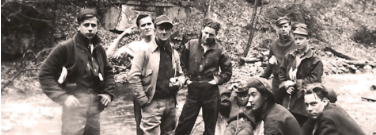The Environmental Contributions of the Civilian Conservation Corps

By Iva Fedorka
Photos supplied by Celeste Beley
On April 5, 1933, newly elected President Franklin D. Roosevelt signed an executive order that allocated $10 million for emergency conservation work, launching the Civilian Conservation Corps (CCC). By midyear, 250,000 men had signed up.
The Need for Employment
In the United States, stock market prices fell precipitously on October 24, 1929. Despite government efforts to counteract the effects of this economic event, it triggered a ten-year period known as the Great Depression. By 1933, 24.9 percent of the national work force of 12,830,000 people were unemployed.
The CCC initially provided jobs for six months to unmarried and unemployed men between the ages of 18 and 25. The men worked in CCC camps, which were located on U.S. Army bases, in national parks, and in state parks and forests. The Army provided shelter, clothing, food, medical supplies, and equipment to the camps, while foresters, carpenters, and other government employees directed the work.
From 1933 to 1942, close to three million workers and their families received support from this national work relief program. The CCC itself had another 250,000 salaried employees, including teachers who taught 57,000 of the enrollees to read and write.
One Man’s Story
William Koban (1923–2006), the grandfather of Thermo Fisher Scientific colleague Celeste Beley, joined the CCC around 1940. Koban was assigned to Haineyville Camp S-82-PA in Clinton County, Pennsylvania, approximately 215 miles from his home in Aliquippa, PA.
The work at Haineyville Camp was supervised by what is now the Pennsylvania Department of Conservation and Natural Resources. Koban worked in reforestation, planting trees, fighting fires, and building fire towers and fire trails.
Like other enrollees, Koban was given a uniform, fed regularly, and paid one dollar a day. Most of his earnings were sent to his family, a condition of enrollment. Since his brother John had also joined the CCC around the same time, their wages were critical for their parents and four other siblings, especially since their father only worked 26 weeks during 1939.
Koban recalled his CCC experience and fellow enrollees fondly, often telling stories about their activities, antics, and comradery. When the U.S. entered World War II, Koban joined the Army and served from 1943 to 1945. During that time, he was captured by the Germans and was held for 19 months in Stalag 2B, a prisoner of war (POW) camp. He also received the Purple Heart.
Accomplishments
CCC members planted 3 billion trees to revitalize U.S. national forests and reduce the risk of dust storms. They established and landscaped 711 state parks and built lodges and hiking trails in national parks, historic battlefields, and other monument areas.
The value of the work performed nationwide by the CCC totals an estimated $8 billion. Although the CCC ended in 1942 with the onset of U.S. involvement in World War II, its contributions to and support of our environment and natural resources are still evident today.
Discussion Questions
- What is reforestation and why is it important?
- What organizations currently perform similar functions to the CCC?
- What is a Purple Heart?